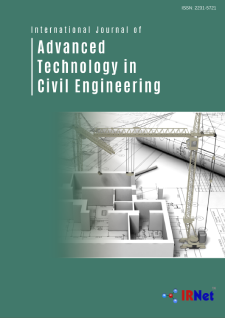International Journal of Advanced Technology in Civil Engineering IJATCE
ISSN: 2231-5721

Abstracting and Indexing


IJATCE
Minimise Cost Overrun Using Sustainable Construction Materials in Sri Lankan Construction Industry
Iddamalgoda Pathiranage Tharindu Sandaruwan
Liverpool John Moores University, United Kingdom
Jayasinghe Aarachchige Bihara Janardana
International College of Business and Technology
Kesavan Manoharan Mr.
Wayamba University, Sri Lanka
Abstract
A successful construction project is determined when it is completed within the expected budget and time, ensuring the required levels of quality and safety. For a project to be successful, it is essential to plan properly and have a reliable monitoring system in place. Furthermore, the building construction sector has a negative impact on the environment by generating waste, increasing carbon emissions, polluting the air and water, and accelerating climate change. This study intends to investigate cost overrun prevention strategies in Sri Lanka using sustainable building materials. Accordingly, a mixed-method research approach was selected, and an e-based closed-ended questionnaire survey and semi-structured expert interviews were carried out to collect data from construction industry professionals. In the questionnaire survey, a total of 80 construction industry experts were selected from different job categories as the respondents, and 53 responses were received with a response rate of 66.25%. On the other hand, 10 construction professionals participated in the semi-structured interview. The study has identified 15 factors that significantly impact cost overrun in the Sri Lankan building construction sector based on the mean weight ratings. The study found that using sustainable alternatives to natural resources at a lower cost is preferable. The most workable solutions to control the identified critical factors were determined to be new policies for sustainable construction, new financial frameworks for importing sustainable materials, new construction methods and technologies associated with sustainable materials and controlling the monopoly of sustainable material suppliers or manufacturers.
Recommended Citation
Hussin, J. M., Rahman, I. A., & Memon, A.
H. (2013). The Way Forward in
Sustainable Construction: Issues and
Challenges. International Journal of
Advances in Applied Sciences
(IJAAS), 2(1), 31-42.
Abeynayake, M. (2010). Legal Aspects
Concerning Sustainable Buildings
and Cities Relating to the Urban
Development in Sri Lanka.
Colombo: University of Moratuwa
Ahady, S., Gupta, S., & Malik, R. (2017). A
critical review of the causes of cost
overrun in construction industries in
developing countries. International
Research Journal of Engineering
and Technology (IRJET), 4(3), 2250-
2258.
Akadiri, P. O. (2015). Understanding
barriers affecting the selection of
sustainable materials in building
projects. Journal of Building
Econimics, 4, 86-93.
Ali, A., & Kamaruzzaman, S. (2010). Cost
performance for building construction projects in klang valley.
Journal of Building Performance,
I(1), 98-105.
Ali, H., & Nsairat, F. (2009). Developing a
green building assesment tool for
developing countries - case of
Jordan. Building and Environment,
44(5), 1053-1064.
Apolot, R., Arinaitwe, H., & Tindiwensi, D.
(2013). Investigation into the Causes
of Delays and Cost Overruns in
Uganda's Public Sector Construction
Projects. Journal of Construction in
Developing Countries, 18, 33-47.
Aram, S., Eastman, C., & Beetz, J. (2014).
Qyalitative and Quantitative Cost
Estimation. Methodol Anal, 381-389.
Azhar, N., Farooqui , R. U., & Ahmed, S.
M. (2008). Cost Overrun Factors In
Construction Industry of Pakistan.
Karachi: Academia.
Buckley, S. (2020). Sustainable
Construction & Building Materials.
Retrieved June 14, 2021, from
https://www.architectureanddesign.c
om.au/features/list/sustainable-
construction-building-
materials#:~:text=Nine%20sustainab
le%20building%20materials%3A%2
01%20Green%20thermal%20insulati
on,Cork%209%20Cement%20made
%20out%20of%20recycled%20plasti
c
Central Bank of Sri Lanka. (2020). Central
Bank Report. Colombo: Central
Bank of Sri Lanka.
Chigara, B., Moyo, T., & Fungai, H. M.
(2013). An Analysis of Cost
Management Strategies Employed
by Building Contractors on Projects
in Zimbabwe. International Journal
of Sustainable Construction Engineering & Technology (ISSN:
2180-3242), 4(2), 1-13.
Creswell, J. (2014). Research Design:
Qualitative, Quantitative and Mixed
Methods Approaches (4 ed.).
Thousand Oaks: CA:Saga.
Dissanayake, R. (2015). GREEN
BUILDINGS FOR SUSTAINABLE
BUILT NVIRONMENT IN SRI
LANKA. Colombo: Green Building
Council Of Sri Lanka.
Dobson, D. W., Sourani, A., Sertyesilisik,
B., & Tunstall, A. (2013).
Sustainable Construction: Analysis
of Its Costs and Benefits. American
Journal of Civil Engineering and
Architecture, 2(1), 32-38.
Green Building Council of Sri Lanka.
(2018). Green Rating System for
Built Environment (2 ed.). Colobmo:
Green Building Council of Sri
Lanka.
Green Building Council Sri Lanka
(GBCSL). (2010). Green SL®
Rating System for Built Environment.
Colombo: Green Building Council
Sri Lanka (GBCSL).
Hammed, M., Ismail, A., & Mohd, R.
(2010). Factors affecting
construction cost in mara large
construction project. International
Journal of Sustainable Construction
Engineering And Technology, 1(2),
41-43.
Hammed, M., Ismail, A., & Mohd, R.
(2010). Factors affecting
construction cost in mara large
construction project. International
Journal of Sustainable Construction
Engineering And Technology, I(2),
41-43.
Hannigan, P., Rausche, F., Garland, L.,
Robinson, B., Becker, M., & Shelsta,
H. (2016). Design and construction
of driven pile foundations.
Washington: US Department of
Transportation.
Hiroshan , S., & Hadiwattege, C. (2014).
FACTORS AFFECTING
CONSTRUCTION COSTS IN SRI
LANKA. Colombo: Ceylon Insitute
of Building.
Jayasekara, S. (2017). INTERNATIONAL
FORESTRY AND ENVIRONMENT
SYMPOSIUM. Retrieved 3 21, 2017,
from
http://journals.sjp.ac.lk/index.php/fes
ympo/article/view/3368
Kushani, I. A., & Karunasena, G. (2018).
Framework for sustainable
construction practices in Sri Lanka.
Built Environment Project and Asset
Management, 8(1), 51-63.
Madushanka, H., & Tilaksiri, K. (2020). The
Identification and Management of
Major Risks in Sri Lankan
Construction Industry. IOSR Journal
of Economics and Finance, 16-23.
Malkanthi, S. N., Premalal, A., & Mudalige,
R. (2017). Impact of Cost Control
Techniques on Cost Overruns in
Construction Projects. Journal of the
Institution of Engineers, Sri Lanka,
50(4), 53-60.
Mohamed, J. I., De Silva, M., &
Waiydasekara, K. (2021). Impact of
Utility Works in Road Projects in Sri
Lanka and Proposed Mitigation
Measures. FARU2021-14th
International Research Conference
(pp. 94-103). Katubedda: University
of Moratuwa
Niknam, M., & Karshenas, S. (2015).
Intergrating distributed sources of
information for construction cost
estimating using semantic web and
semantic web service technologies.
Automation in Construction(57),
222-238.
Park, Y., & Papadopoulou, T. (2012).
Causes of Cost Overruns in
Transport Infrastructure Projects in
Asia. Built Environment Project and
Asset Management, 2(2), 195-216.
Patel, A., Jain, A., & Saraswat, S. (2016).
Causes and Effects of Cost Overrun
on Building Construction Projects.
International Journal for Scientific
Research & Development, 4(4), 936-
937.
Ramachandra, T., Geekiyanage, D., &
Perera, S. L. (2016). A STUDY ON
THE APPLICATION OF
ECONOMIES OF SCALE IN THE
CONSTRUCTION INDUSTRY:
THE SRI LANKAN
PERSPECTIVE. Colombo: Ceylon
Institute of Builders.
Saleh, S. (2008). Factors affecting the
performance of construction projects
in the gaza strip (Published master’s
thesis). Gaza: The Islamic university
of Gaza.
Sandanayake, M., Zhang, G., Setunge, S., &
Thomas, C. (2014). Environmental
emissions of equipment usage in pile
foundation construction process.
Chongqing: International
Symposium on the Advancement of
Construction Management and Real
Estate (CRIOCM).
Shah, R. (2016). An Exploration Of Causes
For Delay And Cost Overrun In
Construction Projects: A Case Study
Of Australia, Malaysia & Ghana Journal of Advanced College of
Engineering and Management, 2(1),
41-55.
Thabani, N. (2019). Cost overrun factors in
constructionindustry: a case of
Zimbabwe. Harare: University of
Zimbabwe.
Thanushan, K. (2012). Factors influencing
the Accuracy of Pre-Tender Cost
Estimate. Moratuwa: University of
Moratuwa.
Ubani, E., & Okoroji, L. (2013). Analysis of
Environment Impact Factors That
Constrain Successful Delivery of
Rural Road Construction Projects.
Journal of Culture, Society and
Development, 1-7.
aardini, U. S., Karthiyayini, S., &
Ezhilmathi, P. (2016). Study on Cost
Overruns in Construction Projects -
A Review. International Journal of
Applied Engineering Research, II(3),
356-363.
Vaardini, U. S., Karthiyayini, S., &
Ezhilmathi, P. (2016). STUDY ON
COST OVERRUNS IN
CONSTRUCTION PROJECTS –A
REVIEW. International Journal of
Applied Engineering Research, II(3),
356-363.
Vinishya, V. (2021). COVID-19 Pandemic-
Induced Economic in Sri Lanka Eye.
Construction Management, 12(3),
60-69.